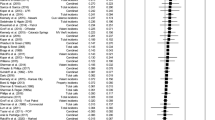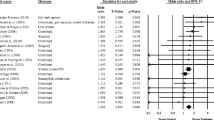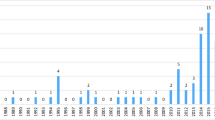Abstract
Objectives
Evaluations from a recent Campbell systematic review of focused deterrence programs are critically reviewed to determine whether more rigorous evaluations are possible given methodological challenges such as developing appropriate units of analysis, generalizing findings beyond study sites, and controlling for the contamination of available comparison groups.
Methods
We synthesize the available evaluation literature on focused deterrence programs completed before and after the publication of the Campbell review to assess opportunities to conduct randomized controlled trials and stronger quasi-experimental evaluations.
Results
We find that focused deterrence strategies are amenable to more rigorous evaluation methodologies such as block randomized place-based trials, multisite cluster randomized trials, and quasi-experimental evaluations that employ advanced statistical matching techniques.
Conclusions
Focused deterrence programs can, and should, be subjected to more rigorous tests that generate more robust evidence on program impacts and provide further insight into the crime control mechanisms at work in these programs. More generally, our review supports the idea that program evaluators do not have to “settle for less” methodological rigor when testing large area-based crime prevention programs.


Similar content being viewed by others
Notes
Propensity score-matching techniques attempt to create equivalent treatment and comparison groups by summarizing relevant pre-treatment characteristics of each subject into a single-index variable (the propensity score) and then matching subjects in the untreated comparison pool to subjects in the treatment group based on values of the single-index variable (Rosenbaum and Rubin 1983, 1985).
Statistical power estimates were calculated using the “Optimal Design” software available from the University of Michigan (http://sitemaker.umich.edu/group-based/optimal_design_software).
Cluster randomized controlled trials introduce dependence among the subjects within each cluster. In the proposed work, two gangs sampled from the same clique are more likely to be similar in terms of outcomes than gangs sampled from other cliques. HLMs are used to adjust for this lack of independence and account for both individual gang level and gang cluster level covariates.
Based on the Campbell review selection criteria, HOPE was not included in the final Braga and Weisburd (2012) review. However, several scholars contacted during their search for eligible studies believed that HOPE did fit within the general framework of pulling levers-focused deterrence strategies. We agree that it is broadly similar to the Chicago PSN, as both are focused on corrections populations. The key elements of Chicago PSN strategy are administered by the Illinois Department of Correction and the U.S. Attorney’s Office (the call-in session is given to returning parolees to selected neighborhoods). The contribution of the Chicago Police Department is limited to increasing their gun policing efforts in the selected neighborhoods. Moreover, probation has a central role in all the gang-/group-based focused deterrence interventions included in our review. Monitoring offenders in the community to ensure they are abiding by probation conditions, changing conditions, and revoking probation are key levers that are pulled in the application of focused deterrence strategies to gangs and criminally active groups. Finally, most applications of pulling levers-focused deterrence strategies have therapeutic elements (e.g., Braga et al. 2001; Papachristos et al. 2007).
There are, of course, other rigorous quasi-experimental evaluation frameworks that can be applied to place-based policing interventions. For instance, Braga et al. (2011) used propensity score models to match treated high violence street segments and intersections to untreated high violence street segments and intersections in Boston to evaluate a place-based policing program. More recently, Saunders et al. (2014) applied a synthetic control group quasi-experimental design to evaluate the High Point DMI program. The synthetic control approach has been used successfully in political science to measure the economic impact of terrorist conflict in Basque Country (Abadie and Gardeazabal 2003) and tobacco prevention legislation in California (Abadie et al. 2010).
Personal communication with Jessica Saunders of the Rand Corporation (October 19, 2013).
References
Abadie, A., & Gardeazabal, J. (2003). The economic costs of conflict: a case study of the Basque country. American Economic Review, 93, 113–132.
Abadie, A., Diamond, A., & Hainmueller, J. (2010). Synthetic control methods for comparative case studies: estimating the effect of California’s tobacco control program. Journal of the American Statistical Association, 105, 493–505.
Albright, J., & Marinova, D. (2010). Estimating multilevel models using SPSS, Stata, SAS, and R. http://www.indiana.edu/~statmath/stat/all/hlm/hlm.pdf.
Berk, R. (2005a). Knowing when to fold ‘em: an essay on evaluating the impact of ceasefire, compstat, and exile. Criminology & Public Policy, 4, 451–466.
Berk, R. A. (2005b). Randomized experiments as the bronze standard. Journal of Experimental Criminology, 1, 417–433.
Boruch, R. F. (1975). On common contentions about randomized field experiments. In R. F. Boruch & H. L. Reicken (Eds.), Experimental testing of public policy: The proceedings of the 1974 social sciences research council conference on social experimentation (pp. 107–142). Boulder, CO: Westview Press.
Boruch, R. F. (1997). Randomized experiments for planning and evaluation. Newbury Park, CA: Sage.
Boyle, D. J., Lanterman, J., Pascarella, J., & Cheng, C. C. (2010). The impact of Newark’s operation ceasefire on trauma center gunshot wound admissions. Newark, NJ: University of Medicine and Dentistry of New Jersey, Violence Institute of New Jersey.
Boyum, D. A., Caulkins, J. P., & Kleiman, M. (2011). Drugs, crime, and public policy. In J. Q. Wilson & J. Petersilia (Eds.), Crime and public policy (pp. 368–410). New York: Oxford University Press.
Braga, A. A. (2008). Pulling levers focused deterrence strategies and the prevention of gun homicide. Journal of Criminal Justice, 36, 332–343.
Braga, A. A. (2010). Setting a higher standard for the evaluation of problem-oriented policing initiatives. Criminology & Public Policy, 9, 173–182.
Braga, A. A. (2012). Getting deterrence right? evaluation evidence and complementary crime control mechanisms. Criminology & Public Policy, 11, 201–210.
Braga, A. A. (2013). Quasi-experimentation when random assignment is not possible: observations from practical experiences in the field. In B. C. Welsh, A. A. Braga, & G. Bruinsma (Eds.), Experimental criminology: prospects for improving science and public policy (pp. 223–252). New York: Cambridge University Press.
Braga, A. A., & Bond, B. J. (2008). Policing crime and disorder hot spots: a randomized controlled trial. Criminology, 46, 577–607.
Braga, A. A., & Weisburd, D. (2012). The effects of “pulling levers” focused deterrence strategies on crime. Campbell Systematic Reviews. doi:10.4073/csr.2012.6.
Braga, A. A., Weisburd, D. L., Waring, E. J., Green-Mazerolle, L., Spelman, W., & Gajewski, F. (1999). Problem-oriented policing in violent crime places: a randomized controlled experiment. Criminology, 37, 541–580.
Braga, A. A., Kennedy, D. M., Waring, E. J., & Piehl, A. M. (2001). Problem-oriented policing, deterrence, and youth violence: an evaluation of Boston’s operation ceasefire. Journal of Research in Crime and Delinquency, 38, 195–225.
Braga, A. A., Hureau, D. M., & Winship, C. (2008a). Losing faith? police, black churches, and the resurgence of youth violence in Boston. Ohio State Journal of Criminal Law, 6, 141–172.
Braga, A. A., Pierce, G., McDevitt, J., Bond, B., & Cronin, S. (2008b). The strategic prevention of gun violence among gang-involved offenders. Justice Quarterly, 25, 132–162.
Braga, A. A., Hureau, D. M., & Papachristos, A. V. (2011). An ex-post-facto evaluation framework for place-based police interventions. Evaluation Review, 35, 592–626.
Braga, A. A., Apel, R., & Welsh, B. (2013). The spillover effects of focused deterrence on gang violence. Evaluation Review, 37, 314–342.
Braga, A. A., Hureau, D. M., & Papachristos, A. V. (2014). Deterring gang-involved gun violence: measuring the impact of Boston’s operation ceasefire on street gang behavior. Journal of Quantitative Criminology, 30, 113–139.
Campbell, D. T., & Boruch, R. F. (1975). Making the case for randomized assignment to treatment by considering the alternatives. In C. Bennett & A. Lumsdaine (Eds.), Evaluation and experiments: some critical issues in assessing social programs (pp. 195–296). New York: Academic.
Clarke, R. V. (Ed.). (1997). Situational crime prevention: successful case studies. New York: Harrow and Heston.
Clarke, R. V., & Cornish, D. (1972). The controlled trial in institutional research. London: H.M. Stationary Office.
Cohen, J. (1988). Statistical power analysis for the behavioral sciences (2nd ed.). Hillsdale, NJ: Erlbaum.
Cook, P. J. (2012). Editorial introduction: the impact of drug market pulling levers policing on neighborhood violence. Criminology & Public Policy, 11, 161–164.
Cook, T. D., & Campbell, D. T. (1979). Quasi-experimentation: design and analysis issues for field settings. Chicago: Rand McNally.
Cook, P. J., & Ludwig, J. (2006). Aiming for evidence-based gun policy. Journal of Policy Analysis and Management, 48, 691–735.
Corsaro, N., & McGarrell, E. (2009). An evaluation of the Nashville drug market initiative (DMI) pulling levers strategy. East Lansing, MI: Michigan State University.
Corsaro, N., Brunson, R., & McGarrell, E. (2010). Problem-oriented policing and open-air drug markets: examining the Rockford pulling levers strategy. Crime & Delinquency. doi:10.1177/0011128709345955.
Corsaro, N., Hunt, E., Hipple, N. K., & McGarrell, E. (2012). The impact of drug market pulling levers policing on neighborhood violence: an evaluation of the high point drug market intervention. Criminology & Public Policy, 11, 167–200.
Durlauf, S., & Nagin, D. (2011). Imprisonment and crime: can both be reduced? Criminology & Public Policy, 10, 13–54.
Eck, J. (2002). Learning from experience in problem-oriented policing and situational prevention: the positive functions of weak evaluations and the negative functions of strong ones. In N. Tilley (Ed.), Evaluation for crime prevention, crime prevention studies (Vol. 14, pp. 93–117). Monsey, NY: Criminal Justice Press.
Engel, R. S., Corsaro, N., & Skubak Tillyer, M. (2010). Evaluation of the Cincinnati initiative to reduce violence (CIRV). Cincinnati, OH: University of Cincinnati Policing Institute.
Fagan, J. (2002). Policing guns and youth violence. The Future of Children, 12, 133–151.
Farrington, D. P., Gottfredson, D. C., Sherman, L. W., & Welsh, B. C. (2006). The Maryland scientific methods scale. In L. W. Sherman, D. P. Farrington, B. C. Welsh, & D. L. MacKenzie (Eds.), Evidence-based crime prevention (revth ed., pp. 13–21). New York: Routledge.
Fisher, R. A. (1926). The arrangement of field experiments. Journal of the Ministry of Agriculture of Great Britain, 33, 503–513.
Fisher, R. A. (1935). The design of experiments. Edinburgh: Oliver and Boyd.
Goldstein, H. (1990). Problem-oriented policing. Philadelphia, PA: Temple University Press.
Guerette, R. T. (2009). The pull, push, and expansion of situational crime prevention evaluation: an appraisal of thirty-seven years of research. In J. Knutsson & N. Tilley (Eds.), Evaluating crime reduction initiatives, crime prevention studies (Vol. 24, pp. 29–58). Monsey, NY: Criminal Justice Press.
Harless, W. (2013). Cities use sticks, carrots to rein in gangs. October: Wall Street Journal. 14.
Hawken, A. & Kleiman, M. (2009). Managing drug involved probationers with swift and certain sanctions. Final report submitted to the National Institute of Justice. Unpublished report.
Heckman, J., & Smith, J. (1995). Assessing the case for social experiments. Journal of Economic Perspectives, 9, 85–110.
Kennedy, D. (1997). Pulling levers: chronic offenders, high-crime settings, and a theory of prevention. Valparaiso University Law Review, 31, 449–484.
Kennedy, D. (2008). Deterrence and crime prevention. New York: Routledge.
Kennedy, D., & Wong, S.-L. (2009). The high point drug market intervention strategy. Washington, DC: Community Oriented Policing Services, U.S. Department of Justice.
Kennedy, D., Piehl, A., & Braga, A. A. (1996). Youth violence in Boston: gun markets, serious youth offenders, and a use-reduction strategy. Law & Contemporary Problems, 59, 147–196.
Kennedy, D. M., Braga, A. A., & Piehl, A. M. (1997). The (un)known universe: mapping gangs and gang violence in Boston. In D. L. Weisburd & J. T. McEwen (Eds.), Crime mapping and crime prevention (pp. 219–262). Monsey, NY: Criminal Justice Press.
Knutsson, J. (2009). Standards of evaluations in problem-oriented policing projects: Good enough? In J. Knutsson & N. Tilley (Eds.), Evaluating crime reduction initiatives, Crime prevention studies (24th ed., pp. 7–28). Monsey, NY: Criminal Justice Press.
LaVigne, N., & Lowry, S. (2011). Evaluation of camera use to prevent crime in commuter parking facilities: a randomized controlled trial. Washington, DC: Urban Institute.
Lipsey, M. W., & Wilson, D. B. (2001). Practical meta-analysis. Thousand Oaks, CA: Sage.
Ludwig, J. (2005). Better gun enforcement, less crime. Criminology & Public Policy, 4, 677–716.
MacKenzie, D. L., Umamaaheswar, J., & Lin, L.-C. (2013). Multisite randomized trials in criminology. In B. C. Welsh, A. A. Braga, & G. Bruinsma (Eds.), Experimental criminology: prospects for improving science and public policy (pp. 163–193). New York: Cambridge University Press.
Manski, C. F. (2013). Public policy in an uncertain world: analysis and decisions. Cambridge, MA: Harvard University Press.
McCord, J. (2003). Cures that harm: unanticipated outcomes of crime prevention programs. Annals of the American Academy of Political and Social Science, 587, 16–30.
McGarrell, E., Chermak, S., Wilson, J., & Corsaro, N. (2006). Reducing homicide through a ‘lever-pulling’ strategy. Justice Quarterly, 23, 214–229.
Miles, T., & Ludwig, J. (2007). The silence of the lambdas: deterring incapacitation research. Journal of Quantitative Criminology, 23, 287–301.
Morgan, S. L., & Winship, C. (2007). Counterfactuals and causal inference: methods and principals for social research. New York: Cambridge University Press.
Mosteller, F., & Boruch, R. F. (2002). Evidence matters: randomized trials in educationresearch. Washington, DC: Brookings Institution.
Murray, D. M. (1998). Design and analysis of group-randomized trials. New York: Oxford University Press.
Papachristos, A. V., Meares, T., & Fagan, J. (2007). Attention felons: evaluating project safe neighborhoods in Chicago. Journal of Empirical Legal Studies, 4, 223–272.
Papachristos, A. V., Wallace, D., Meares, T., & Fagan, J. (2013). Desistance and legitimacy: The impact of offender notification meetings on recidivism among high risk offenders. Unpublished manuscript.
Pawson, R., & Tilley, N. (1997). Realistic evaluation. London: Sage.
Raudenbush, S. W., & Bryk, T. (2002). Hierarchical linear models: applications and data analysis methods (2nd ed.). Newbury Park, CA: Sage.
Rosenbaum, P., & Rubin, D. (1983). The central role of the propensity score in observational studies for causal effects. Biometrika, 70, 41–55.
Rosenbaum, P., & Rubin, D. (1985). Constructing a control group using multivariate matched sampling methods that incorporate the propensity score. American Statistician, 39, 33–38.
Rosenfeld, R., Fornango, R., & Baumer, E. (2005). Did ceasefire, compstat, and exile reduce homicide? Criminology & Public Policy, 4, 419–450.
Rubin, D. B. (1990). Formal modes of statistical inferences for causal effects. Journal of Statistical Planning Inference, 25, 279–292.
Sampson, R. J. (2010). Gold standard myths: observations on the experimental turn in quantitative criminology. Journal of Quantitative Criminology, 26, 489–500.
Sampson, R. J., Winship, C., & Knight, C. (2013). Translating causal claims: principles and strategies for policy-relevant criminology. Criminology & Public Policy, 12, 587–616.
Saunders, J., Lundberg, R., Braga, A. A., Ridgeway, G., & Miles, J. (2014). A synthetic control approach to evaluating multiple geographically-focused crime interventions in the same city: DMI in high point. Santa Monica, CA: Rand Corporation.
Shadish, W., Cook, T., & Campbell, D. (2002). Experimental and quasi-experimental designs for general causal inference. Boston: Houghton-Mifflin.
Sherman, L. W., Gottfredson, D. C., MacKenzie, D. L., Eck, J. E., Reuter, P., & Bushway, S. D. (1997). Preventing crime: what works, what doesn’t, what’s promising. Washington, DC: U.S. Department of Justice, National Institute of Justice.
Skogan, W., & Frydl, K. (2004). Fairness and effectiveness in policing: the evidence committee to review research on police policy and practices. Washington, DC: The National Academies Press.
Tilley, N. (2009). What’s the “what” in “what works?” Health, policing, and crime prevention. In J. Knutsson & N. Tilley (Eds.), Evaluating crime reduction initiatives, Crime prevention studies (24th ed., pp. 121–146). Monsey, NY: Criminal Justice Press.
Tita, G., Riley, K. J., Ridgeway, G., Grammich, C., Abrahamse, A., & Greenwood, P. W. (2004). Reducing gun violence: results from an intervention in east Los Angeles. Santa Monica: RAND Corporation.
Weisburd, D. (1993). Design sensitivity in criminal justice experiments. In M. Tonry (Ed.), Crime and justice: a review of research (Vol. 17, pp. 337–379). Chicago: University of Chicago Press.
Weisburd, D. (2003). Ethical practice and evaluation of interventions in crime and justice: the moral imperative for randomized trials. Evaluation Review, 27, 336–354.
Weisburd, D. (2010). Justifying the use of non-experimental methods and disqualifying the use of randomized controlled trials: challenging the folklore in evaluation research in crime and justice. Journal of Experimental Criminology, 6, 209–27.
Weisburd, D., & Eck, J. (2004). What can police do to reduce crime, disorder and fear? Annals of the American Academy of Political and Social Science, 593, 42–65.
Weisburd, D., & Gill, C. (2013). Block randomized trials at places: rethinking the limitations of small N experiments. Journal of Quantitative Criminology. doi:10.1007/s10940-013-9196-z.
Weisburd, D., & Green, L. (1995). Policing drug hot spots: The Jersey City drug market analysis experiment. Justice Quarterly, 12, 711–735.
Weisburd, D., & Taxman, F. (2000). Developing a multi-center randomized trial in criminology: the case of HIDTA. Journal of Quantitative Criminology, 16, 315–339.
Weisburd, D., Lum, C. M., & Petrosino, P. (2001). Does research design affect study outcomes in criminal justice? Annals of the American Academy of Political and Social Science, 578, 50–70.
Weisburd, D., Wyckoff, L., Ready, J., Eck, J. E., Hinkle, J. C., & Gajewski, F. (2006). Does crime just move around the corner? a controlled study of spatial displacement and diffusion of crime control benefits. Criminology, 44, 549–592.
Weisburd, D., Telep, C., Hinkle, J., & Eck, J. (2008). The effects of problem-oriented policing on crime and disorder. Campbell Systematic Reviews. doi:10.4073/csr.2008.14.
Wellford, C. F., Pepper, J. V., & Petrie, C. V. (Eds.). (2005). Firearms and violence: a critical review. committee to improve research information and data on firearms. Washington, DC: The National Academies Press.
Welsh, B. C., & Farrington, D. P. (2009). Making public places safer: surveillance and crime prevention. New York: Oxford University Press.
Welsh, B. C., Peel, M. E., Farrington, D. P., Elffers, H., & Braga, A. A. (2011). Research design influence on study outcomes in crime and justice: a partial replication with public area surveillance. Journal of Experimental Criminology, 7, 183–198.
Wilkinson, L., & Task Force on Statistical Inference. (1999). Statistical methods in psychology journals: guidelines and expectations. American Psychologist, 54, 594–604.
Author information
Authors and Affiliations
Corresponding author
Rights and permissions
About this article
Cite this article
Braga, A.A., Weisburd, D.L. Must we settle for less rigorous evaluations in large area-based crime prevention programs? Lessons from a Campbell review of focused deterrence. J Exp Criminol 10, 573–597 (2014). https://doi.org/10.1007/s11292-014-9205-8
Published:
Issue Date:
DOI: https://doi.org/10.1007/s11292-014-9205-8




